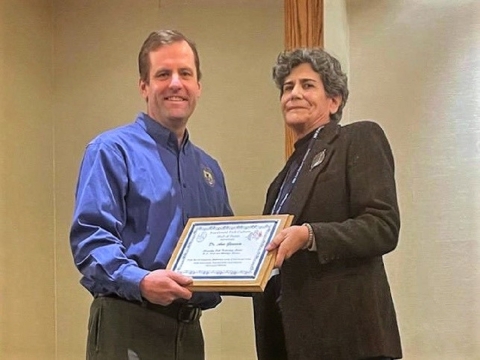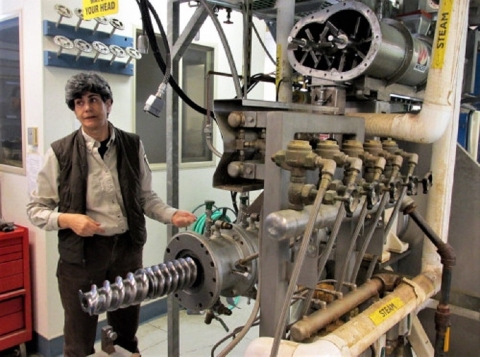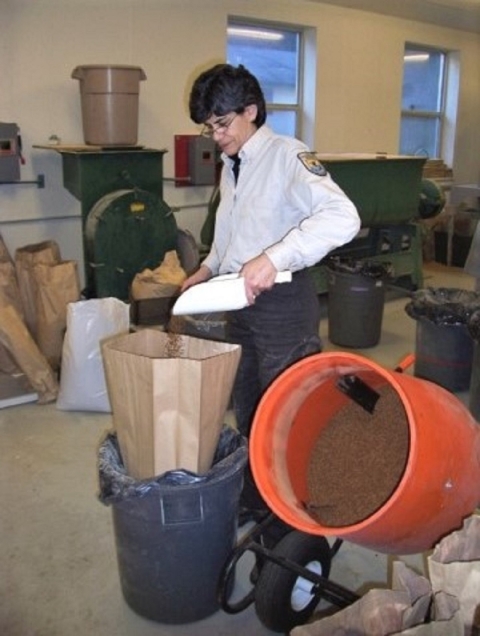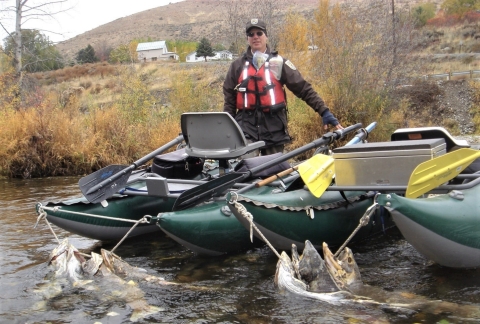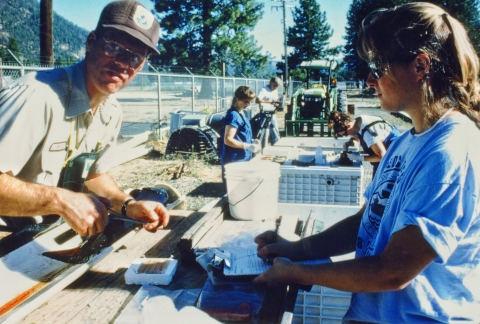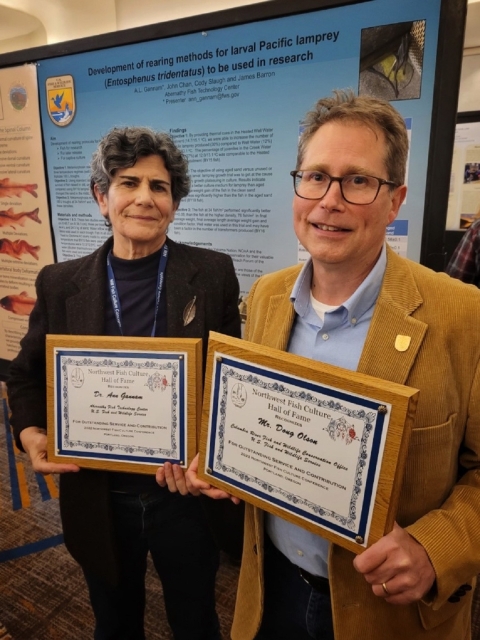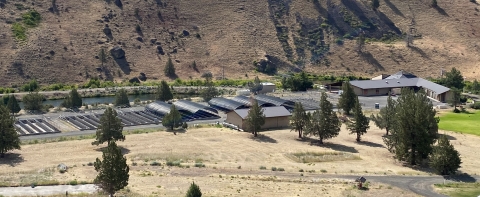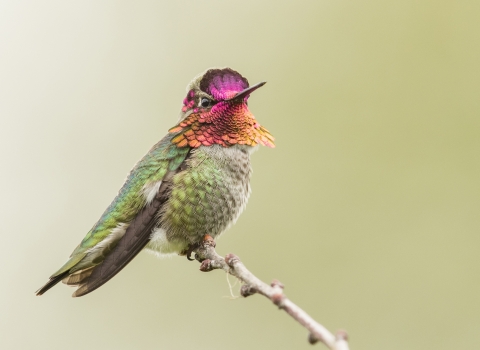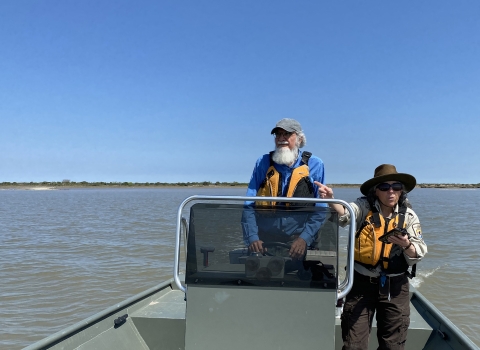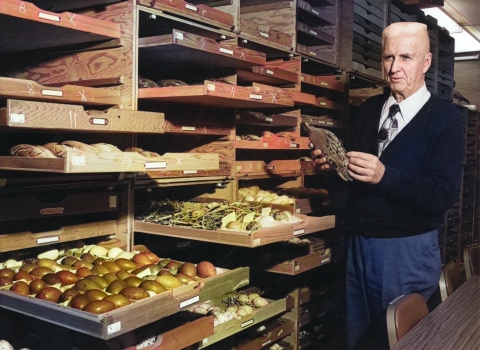Three employees of the U.S. Fish and Wildlife Service’s Pacific Region have been inducted into the Northwest Fish Culture Conference Hall of Fame, including the first woman ever inducted.
Ann Gannam, the regional fish nutritionist at Abernathy Fish Technology Center, became the first woman to be inducted into the hall of fame in its decades-long history. She was inducted along with two now-retired Service members — bio-science technician Chuck Hamstreet, and fish biologist Doug Olson. The announcement was made on Dec. 6, 2022, at the 71st Annual Northwest Fish Culture Concepts Meeting held in Portland, Oregon.
The Northwest Fish Culture Conference is a group of federal, Tribal, and state aquaculture and fisheries management cooperators who meet annually to present on technical fish culture applications and learn the latest in fish culture related products and services. The U.S. Fish and Wildlife Service is hosting the 71st annual meeting, themed, “Cultivating Success — The Future of Aquaculture in the Northwest Region.”
Induction into the Northwest Fish Culture Conference Hall of Fame is an esteemed recognition for an individual’s major roles and contributions in the conference’s extensive history.
Ann Gannam
Gannam is the regional fish nutritionist at Abernathy Fish Technology Center in Longview, Washington. For more than three decades, she has led fish nutrition research studies and the Service’s Fish Feed Quality Control Program, the only program of its kind that monitors the quality of fish feed used at national fish hatcheries. National fish hatcheries raise aquatic species to help recover endangered or threatened species, improve recreational fishing, and fulfill Tribal partnership and trust responsibilities.
Gannam works closely with hatchery managers and fish health professionals from the Service, Tribes, states, and other federal agencies to ensure that quality fish are reared and released from hatcheries. Her work has been instrumental in identifying feed quality problems in real time, getting to resolution with feed manufacturers, avoiding potentially catastrophic losses in hatchery production programs, and providing an uncalculatable financial savings.
“It’s been my great privilege to have known and worked with Dr. Gannam since 1998,” says Judy Gordon, the assistant regional director for the Fish and Aquatic Conservation program in the Pacific Region. “Her quiet determination to use the latest science to provide the best nutrition for the species we rear is not only a huge credit to her strong work ethic but also makes her one of the unsung heroes of the Service, the Pacific Region, and the Fish and Aquatic Conservation Program.”
In addition to her work managing the fish feed program, Gannam is a distinguished researcher. She has developed diets and rearing protocols for both newly captive and Endangered Species Act-listed aquatic species such as Klamath suckers, Pacific lamprey, bloaters, and Western pearlshell mussels.
Gannam is listed as an author on over 50 peer-reviewed professional publications, including several book chapters, many as first author. She continues to provide technical information about fish feed and nutrition as needed to local, national, and international partners and is considered a highly respected, trusted, and extremely knowledgeable member of the fish culture community.
In line with her many notable accomplishments, Gannam is the first woman to be inducted into the Northwest Fish Culture Conference Hall of Fame in its over 70-year-long history.
“Dr. Gannam is an exemplary scientist whose knowledge and experience are highly valued and often sought by a wide range of managers, conservationists, and experts,” says Roger Root, acting center director at Abernathy Fish Technology Center. “Her expertise in nutrition and readiness to collaborate with varied partners have made her a trusted resource for fish culturists and hatchery managers for over 30 years. We are extremely proud she is being recognized for her many contributions to fish culture in the Pacific Northwest and beyond.”
Chuck Hamstreet
Hamstreet served as both a fish culturist and technician assisting in the raising of millions of fish and implementing countless hatchery evaluation projects over his 42 years of public service.
Beginning in 1975 at the Olympia Fisheries Resource Office, Hamstreet took on numerous temporary appointments that gained him a broad suite of valuable technical skills. In 1979, he became a permanent employee who supervised tagging operations around the region; he led surveys, skippered various watercraft in both freshwater and marine settings, and coordinated hatchery sampling at the Olympic Peninsula hatcheries. Hamstreet’s work was heavily focused toward on-the-ground Tribal support and assistance, which often led to working in novel and remote locations with a variety of staff and agencies. Hamstreet’s vast technical toolkit with his ability to get along with others and readily identify where he could have the greatest impact in a team environment continued to further his reputation as the right person for difficult assignments.
Hamstreet continued his career journey to Leavenworth, Washington, first at the Leavenworth National Fish Hatchery then to the Mid-Columbia Fish and Wildlife Conservation Office as lead technician for all office programs from 1994 until his retirement in 2018. He was recognized as the Service’s Fish Culturist of the Year in 1990 while at Leavenworth NFH for his many contributions to improving culture conditions at the hatchery.
“Chuck’s work represents the foundational core of fisheries and the very best of the vast majority of hardworking staff that do most of the heavy lifting that keep our hatcheries operating and fisheries science moving forward. Chuck held to the same values throughout his entire career, specifically that public service and the public’s interest is paramount, kindness and respect for others is not optional but expected, that results matter, and that perseverance and hard work is rewarded. When life throws hurdles your way, you just put your head down and keep moving, and in Chuck’s own words: ‘Do it for the cause, not the applause,’” shared Bill Gale, project leader at the Mid-Columbia Fish and Wildlife Conservation Office, and Matt Cooper, fish biologist at Leavenworth National Fish Hatchery and Hamstreet’s former supervisor.
Doug Olson
Olson devoted over 30 years of his career to assisting and assessing hatchery programs in the Columbia River Basin, working for the Confederated Tribes of the Umatilla Indian Reservation and then for the U.S. Fish and Wildlife Service.
Throughout his career, Olson was a strong advocate for hatchery programs, acknowledging program shortcomings but recognizing the benefits that well managed hatchery programs provide toward conservation, harvest, and Tribal Trust goals. Olson was dedicated to working closely with hatchery, Tribal, and the Service’s Fish Health staff at Warm Springs National Fish Hatchery in Central Oregon to develop and maintain a hatchery program that provided harvest benefits and protected wild fish populations on reservation waters He also helped develop robust hatchery evaluation programs at the five Columbia River Gorge National Fish Hatcheries.
The work by Olson, his team, and staff from the hatcheries resulted in multiple peer-reviewed publications, disseminating information from the applied hatchery science studies to programs throughout the region and country. Olson also took on a variety of additional roles that contributed to the advancement of hatchery programs in the Pacific Northwest.
“We are delighted that Doug Olson is receiving this well-deserved honor. Doug was a valuable member of the Columbia River Fish and Wildlife Conservation Office for three decades,” shared Janine Castro, project leader, and Christina Wang, deputy project leader, at the Columbia River Fish and Wildlife Conservation Office in Vancouver, Washington. “His significant contributions to the hatchery programs and the enduring relationships he formed with our Tribal partners in the Columbia Basin will persist well into the future. Doug embodied his final words to his colleagues on his retirement, ‘Be smart, be analytical, be thoughtful, but manage from the heart.’ That he did!”
Learn more about the U.S. Fish and Wildlife Service’s National Fish Hatchery System: Visit National Fish Hatcheries


